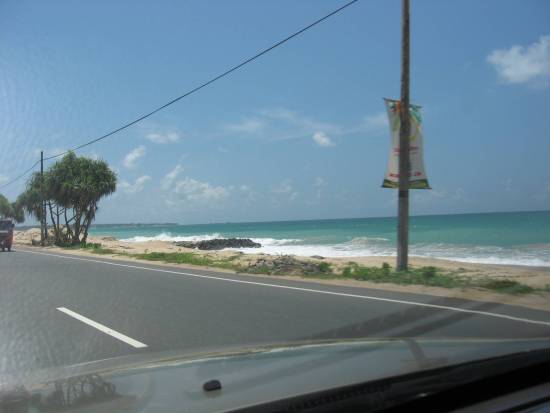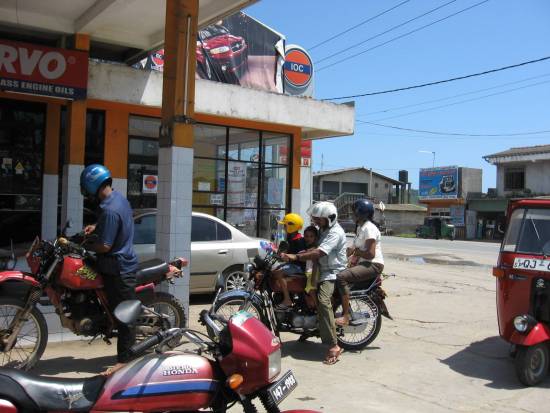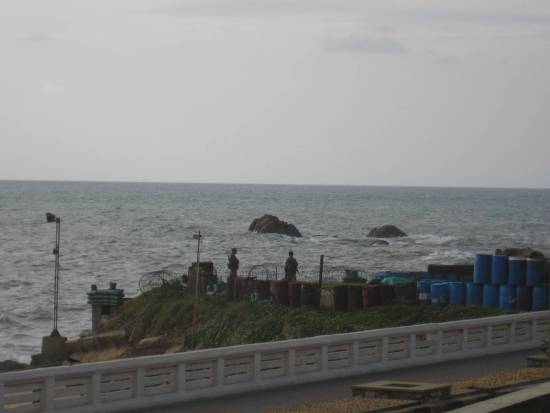Arrival in Colombo at 4.40 am local time. The jetlag with France is four hours and a half. The temperature in the terminal seems to be around 25°C. The customs formalities are rather long, at this early hour of the day there are not many employees working. My passport doesn’t go through the optical scanner ... I feel uncomfortable, after several trials, the customs officer types the information on his computer. A reassuring bip, I can go through the checking. We get our luggage back and carry on towards the exit where I can see a board “Mr Vanlerberghe” hold by our driver/guide. We introduce ourselves very quickly, his name is Srath (pronounced Sarat by rolling one’s r’s). Our luggage trolley is grabbed by an airport carrier. It’s time for a first negotiation, we don’t have local money yet and I don’t want to part with my dollars too easily. We part with a 1 euro coin but we still have to discuss hard because coins are not accepted in banks. Lydie agrees to exchange her 20 euro note for small change but when we checked the amount there were 6 euros missing. We have to keep vigilant after a ten hours’flight!
Srath, a typical Sri-Lankan: smiling, nice and sympathetic takes us in his car. I get on at the front, left side because the driving is on the left in Sri Lanka. Lydie gets on at the back, with one of our suitcases because it’s impossible to put the two suitcases in the boot of the Hyundaï.
 We have about a one hour’s trip up to our hotel in Colombo. It was the occasion to discover the Sri-Lankan driving. To make short, it’s like in Italy, with the horns but much more slowly. The speed limits are very strict, 50km/h in town for cars, 40 for buses, lorries and took-took (three-wheel vehicles used as taxis all over the country). On motorways the limits go up to 70km/h for cars, but what they mean by motorways is slightly different in this country, we’ll come back to this later. Another feature of the traffic here is the liberty of use of the roads. More precisely, it’s quite common, even usual to cross or take over pedestrians of course but also dogs, very numerous throughout the country, and also cows or buffalos in total liberty although domesticated. All these additional users are seen both in town and in country. We also came across other wilder species on the country roads: a few snakes or terrestrial iguanas, peacocks very numerous near the ricefields.
We have about a one hour’s trip up to our hotel in Colombo. It was the occasion to discover the Sri-Lankan driving. To make short, it’s like in Italy, with the horns but much more slowly. The speed limits are very strict, 50km/h in town for cars, 40 for buses, lorries and took-took (three-wheel vehicles used as taxis all over the country). On motorways the limits go up to 70km/h for cars, but what they mean by motorways is slightly different in this country, we’ll come back to this later. Another feature of the traffic here is the liberty of use of the roads. More precisely, it’s quite common, even usual to cross or take over pedestrians of course but also dogs, very numerous throughout the country, and also cows or buffalos in total liberty although domesticated. All these additional users are seen both in town and in country. We also came across other wilder species on the country roads: a few snakes or terrestrial iguanas, peacocks very numerous near the ricefields.
On the road which leads to Colombo and in the capital itself we are impressed by the police and military forces. We can see a checkpoint about every 100 metres. There are at least two soldiers or two policemen with one armed with a Kalashnikov assault rifle or an Uzi tommy gun. Seeing the different uniforms we can guess there’s also a national guard. As for the checkpoints, mobile gates create twists and turns and make people slow down. All vehicles without exception are checked before entering the capital. As for us, only the driver must show his papers, the vehicle is not searched which is not the case for lorries which are inspected at specific checkpoints. The recent events linked to Tamil terrorism make these measures necessary. However despite this reinforced police presence all over the country, there is no particular tension and we don’t feel insecure. Life is normal, there are a lot of people in streets, towns and country. We’ll have the opportunity to see it by ourselves in Hambantota where we walked in the town centre very safely.
can see a checkpoint about every 100 metres. There are at least two soldiers or two policemen with one armed with a Kalashnikov assault rifle or an Uzi tommy gun. Seeing the different uniforms we can guess there’s also a national guard. As for the checkpoints, mobile gates create twists and turns and make people slow down. All vehicles without exception are checked before entering the capital. As for us, only the driver must show his papers, the vehicle is not searched which is not the case for lorries which are inspected at specific checkpoints. The recent events linked to Tamil terrorism make these measures necessary. However despite this reinforced police presence all over the country, there is no particular tension and we don’t feel insecure. Life is normal, there are a lot of people in streets, towns and country. We’ll have the opportunity to see it by ourselves in Hambantota where we walked in the town centre very safely.
Some places are particularly protected, for example the power stations which look like military bases with blockhouses, miradors and machine guns in battery. Guards are in battle dress with a heavy helmet and a bulletproof jacket, weapons and munitions accordingly. Right in town it’s a little surprising but after a few days we don’t pay attention to it anymore.
We arrive at the Continental hotel which is situated in the area where the President of Sri Lanka lives. Therefore the security is reinforced, without being oppressive.
the security is reinforced, without being oppressive.


Ajouter un commentaire